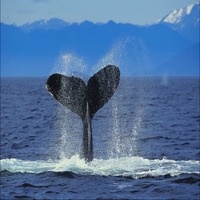The Development of Color Vision

Last year we looked at the research suggesting that the reason why primates developed color visions was so that they could pick up color changes on the faces and posteriors of other apes.
Now researchers at Ohio University have found that after primates evolved the ability to see red, they began to develop red and orange skin and hair.
As we discussed last year, humans, apes and Old World monkeys, such as macaques and leaf monkeys, all have trichromatic vision, allowing them to distinguish between blue, green and red colors. Primatologists have disagreed about whether this type of color vision initially evolved to help early primates forage for ripe fruit and young, to be able to red leaves among green foliage, or to tell the state of anger or arousal in other apes or to help them select mates.

Now a new study published online this week in American Naturalist by Ohio University researchers Andre´Fernandez and Molly Morris suggests that red-color vision evolved for non-social purposes, possibly foraging. But once developed, trichromaticism – i.e. three color vision – drove the evolution of red skin and hair through sexual selection.
Andre´Fernandez first began to question the strict correlation of food choice and color vision while studying howler monkeys in Costa Rica. He recently compiled data on the color vision, social and sexual habits and red skin and pelage (hair, fur and wool) of 203 different primate species.
The researchers then used a phylogenetic tree representing the evolutionary relationships among all the primate species under study to test hypotheses about the order in which the traits of red color vision, gregariousness (highly social behavior) and red coloring evolved. By comparing the traits of individual species in this evolutionary context, Fernandez and Morris could use statistical methods to deduce the probability of their ancestors having the same traits. They could also see if any of the traits were correlated with one another.
They found that the species that could discern red and orange hues were more likely to develop red and orange skin and hair, as well as highly social habits that make it easier to visually compare mates. In fact, the more social the three-color vision apes are, the more red coloring they show.
Fernandez said,
“Neuroscience research has found some evidence of a perceptual bias for more brilliant colors, so it is reasonable for primates with trichromatic color vision to respond more when they see bright colors.”
Molly Morris, the co-author on the paper is a fish biologist who studies how physical traits such as coloring evolve through sexual selection.
She said,
“It looks like red skin and hair became a sexual preference, so while the benefits in terms of eating may not apply anymore, the (red-color) vision in some groups is now relevant in social terms.”
So while foraging may have initially sparked red color vision, the new ability was likely “recruited” for social purposes.
This is not just an interesting little evolutionary tidbit. There are plenty of systems in the human brain that evolved to do one thing, and are now used for something quite different. And sometimes these new uses conflict with some of the other programs running in the brain. This is likely to be one of the causes for some types of psychological problems. when the brain is trying to do too many things at once, and there is an imbalance between the older limbic regions of the brain and the cerebral cortex.
Sex Makes You Fat
Shortly after the earth cooled, I was given a book with the arresting title of the Dieter’s Guide to Weight Loss During Sex.
I have no idea why. Nothing in the title seemed at all relevant to me.
So now I learn that sex makes you fat.
But only if you’re a female tick.

I would like to share with you that after mating, the weight of the female African ixodid tick balloons until she is 100 times her original size. That is truley astonishing.
This observation has lead a researcher from the Department of Biological Sciences at the University of Alberta to investigate what it is about copulation that triggers such a massive weight gain.
In a new paper published in the Journal of Insect Physiology, Dr. Reuben Kaufman suggests that there are several differences between the ixodid tick and other blood-sucking beasties – mosquitoes, tsetse flies, bedbugs and kissing bugs – that may help explain the weight gain. None of them has anything like this kind of weight gain: it seems to be unique to the female African tick.
Kaufman suggests that the ixodid tick displays a significant difference in lifestyle from the other insects and that it is adaptive for the virgin to remain small before mating: she wants to stay below the host’s radar.
This species of tick remains on the host for a number of days, rather than minutes. As Kaufman says,
“In this family of ticks, mating takes place on the host. Most other insects mate before or after their brief blood meal – the two acts are totally separate, but not with these ticks.”
Female ticks require six to 10 days to engorge fully. First, she attaches herself to the skin. Then she feeds to 10 times her unfed weight and finally, after copulation, she increases her weight a further tenfold.
On the other hand, the virgin tick rarely exceeds the critical weight necessary for laying eggs. She will hang on to the host for weeks waiting for a male to find her. If the virgin gains too much weight and is groomed off the host, she will not be able to reattach herself to another host and continue feeding. If she remains small she still has a chance to reattach itself to another host, which hopefully will be infested with some feeding males. Then she cannot only continue feeding, but may also have the chance of meeting a mate.
As Kaufman says,
“If a male eventually copulates with her, she will engorge normally and then be able to lay eggs. This is one reason why it might be adaptive for the virgin to remain small until mated.”
In terms of what causes the female to become so engorged, it seems to have something to do with the exchange of bodily fluids. The male fluids contain two engorgement factor proteins that together act as a signal to tell her to complete engorgement.
This work may sound as if it is a bit out of left field, but it is actually very important. Ticks can be a real problem in many parts of the world: even in Georgia, it is a daily ritual to check the dog, cats and horses for ticks.
This work is part of a research program to produce an anti-tick vaccine. Some experiments have already suggested that normal, mated ticks are unable to fully engorge when feeding on a host that has been immunized against the engorgement factor proteins. If these observations can be confirmed and extended, an effective anti-tick vaccine to protect livestock and pets could be on the horizon.
Why Aren’t We Furry?

For years now, people have wondered why most humans have very little in the way of fur. I have just read about an interesting idea that I hadn’t seen before. The suggestion is that humans are hairless because Stone-Age mothers regarded furry babies as unattractive.
The article was written by written by Judith Rich Harris, the author of two controversial, but challenging and absorbing books: The Nurture Assumption and No Two Alike. The article is entitled “Parental selection: a third selection process in the evolution of human hairlessness and skin color” and was published in the journal Medical Hypotheses. The article just won the 2006 David Horrobin Prize for medical theory, which has been awarded annually and named in honor of Dr. David Horrobin, who was a renowned researcher, expert in biotechnology and founder of Medical Hypotheses, who died in 2003.
In the paper Rich Harris speculates that in Stone Age societies the mother of a newborn had to decide whether she had the resources to nurture her baby. The newborn’s appearance probably influenced whether the mother kept or abandoned it and therefore an attractive baby was more likely to be kept and reared.
Harris’ theory is that this kind of parental selection may have been an important force in evolution. If Stone Age people believed that hairless babies were more attractive than hairy ones, this could explain why humans are the only apes who don’t have a natural fur coat. She goes on to suggest that Neanderthals must have been furry in order to survive the Ice Age in more Northern Regions than the Cro-Magnons from whom we are descended. Our species would have seen them as “animals” and potential prey. So her final hypothesis is that Neanderthals went extinct because our human ancestors ate them.
It is certainly an interesting idea, but I need a bit more convincing. Humans, like most other mammalian species are hardwired to protect the young at all costs, and it difficult to imagine how many Stone Age Sophie’s Choices would have had to have been made to create a hairless species.
We may learn more from continuing research into the fate of the Neanderthals: did they die out, or, as the psychologist and writer Stan Gooch suggested, did we mate with them? Are modern humans not simply the children of Cro-Magnons, but hybrids of Cro-Magnons and Neanderthals?
Stem Cell Treatment for Cerebral Palsy?

Medical News Today is carrying a interesting article entitled, “Dramatic Improvement For 19-Year-Old Hungarian Cerebral Palsy Sufferer After Stem Cell Treatment.”
According to the report a 19-year-old from Hungary named Gabor Bocskai had stem cells injected into the fluid around his spinal cord.
It goes on to say,
“The successful procedure, performed at China’s top stem cell facility, makes Mr. Bocskai the first teenage European CP patient to
see rapid improvement through stem cell therapy. Unedited
videos taken before and after Mr. Bocskai’s injections dramatically demonstrate the profound improvement in his 19-year battle to walk, write, focus his eyes, concentrate, and overcome the many other detrimental effects resulting from the CP he acquired at birth. More details and the videos have been published on China’s leading Stem Cell News site at http://www.stemcellschina.com.
Some of Mr. Bocskai’s most noticeable and immediate physical
improvements after the eight-week stem cell therapy program
include improved vision, increased eye focus and better
concentration on one subject. He also reported clearer writing, enhanced muscle tone, the ability to sit up unsupported, and a new capability to walk and swim in an unassisted manner. As a lifelong quadriplegic with paralysis in his lower limbs, Mr. Bocskai was never able to walk independently, using a wheelchair for transportation. Within four months of the initial treatment, he stated that he was able to walk with the help of a walker and no other support, and at a rate three times faster than ever before with increased maneuverability in his legs and torso. Even his
speech became clearer and faster.
In Mr. Bocskai’s most recent blog entry dated March 11, 2007, he excitedly stated, “My ability to concentrate has increased up to 6 hours a day as a result of stem cell treatment, so studying is much easer than before. I no longer get tired from learning.” (Gabor’s CP Blog is at
http://www.stemcellschina.com/blogs/Gabor%20cp/)The
Hospital announced that Mr. Bocskai has since returned to
Hungary from China and has reported continued daily
improvement. It also cautioned that not every teenage CP
patient treated with stem cell therapy should expect the
same impressive results.”
There is very little information on the procedure, and I could not find any information about where the stem cells came from. I do see that he also had “certain medications” as well as hyperbaric oxygen.
The article is so enthusiastic that it reads like an advertisement!
I do very much hope that Gabor gets some real help from all of these treatments, but we need to be very cautious until we have a great deal more information not just about the science, but also the ethics of the treatment that he has had. For example, where did the stem cells come from? Do we know that they were stem cells?
It is always great to hear about success stories, but sad to say, we then need to do the boring bit: the checking, the testing and the replicating that go into sustainable medical progress.
I have done an extensive literature search and cannot find any published scientific reports, but I only covered the languages that I can read. So there could be something in Chinese that I missed.
I shall let you know immediately if we find out any more about the use of stem cell treatments in humans.
The Accelerating Open Access Revolution
It is only a couple of days since I last wrote something on the revolution in open access to information, but here are two new things that I need to share with you.
First, today saw the launch of the journal Open Medicine.
These are a couple of extracts from James Maskalyk’s editorial in the inaugural issue:
…To attain their true worth, medical journals need to place the knowledge on their pages into as many capable hands as possible. In the past, this opportunity was limited mainly to those with a university library close by. Now, because of the Internet, one simply needs to be near a telephone line. The capacity of medical journals to disseminate knowledge has never been greater…
Unfortunately, physicians attempting to answer a clinical question are faced with two unappealing options: to navigate a sea of unedited pages of varying quality, or to pay for access to more carefully reviewed scholarly information. It seems an anathema to the spirit of medical research that, largely for economic reasons, the information it produces remains hidden from many potential users. Access is limited not only for health professionals in poorer countries, but also for health care providers in wealthy countries (most of whom do not have "free" access to information unless they work in universities), and for patients, who deserve the opportunity to become informed about research that affects their lives. The transformation of research findings and discussion of the results — the application of knowledge — is curtailed. Just as importantly, the debate over its merit is stifled before it can properly begin….
Medical knowledge should be public and free from undeclared influence. When possible, it should be free for those who apply it. Since people’s lives depend on it, that knowledge must be filtered several times before it is ready to use. Studies need to be peer reviewed, to have their statistics analyzed, their content edited, then copy edited, then published quickly for as wide an audience as possible. The prospect of having a high-quality source of information that held true to these principles but was also free and globally accessible was impossible to imagine 20 years ago….
The second thing is something very helpful on Peter Suber’s excellent blog:
OA podcasts from non-OA journals
Charles W. Bailey Jr. has collected some links for journals offering OA podcasts.
In
a recent SSP-L message, Mark Johnson, Journal Manager of HighWire
Press, identified three journals that offer podcasts or digital audio
files:Here are a few others:
Biomedical Journals and Open Access

I have written before about my enormous admiration for the global attempt to make research freely available to everyone. This is such an important step toward patient empowerment and greater transparency in science and medicine.
There is currently an online petition to support free and open access to European research, and if you also believe in the principles of integrity, transparency and personal empowerment, you may want to consider signing.
I was gratified to see how many major journals are now making articles immediately and permanently available online
without charge. A number of journals require an institutional or a
personal subscription to view other content, such as reviews or paper
reports. Free trial subsciptions to these journals are available.
This seems to be the most up-to-date listing, and everyone involved really deserves our gratitude. I shall continue to update this list as more journals become involved.
| A B C D E F G H I J K L M N O P X Y Z |
||
|
The Song of the Whales

I suppose that it has something to do when I grew up, but I’ve always been fascinated by animal communications in general and the amazing songs of the whales in general.
A few years ago I was speaking at a conference in Maui, and I stopped speaking and took the assembled throng outside because some migrating whales were coming in very close to shore. Our wait as not in vain: I saw something that I’d only ever seen on documentaries: two adult whales and their calf leaping out of the water in harmony. Later that day someone took me out beyond the surf and had me swim underwater. The whale song was crystal clear, even though some of the whales were now miles away.
A few months ago I wrote about the data suggesting that dolphins call each other by name. Web Mistress Carol has just sent me a report of some research that was published in January by a group from the Scripps Institute of Oceanography in the journal Marine Ecology Progress Series.
The scientists used harmless tags suctioned to the whales’ bodies, to track the whales and found that as they feed they send out calls to let each other know where they are. Each group employs a different sound.
The noises play a similarly important role during mating season when males sing long, low-pitched songs to indicate their reproductive fitness to females. Females select mates based on size and estimate that by evaluating males’ songs: Larger males can take in more air and hold notes longer.
A related study, also by Scripps researchers, found that there are distinct “dialects” of whale-speak in different regions of the ocean.
The scientists used acoustic recordings to delineate nine population regions worldwide. They found the whales weren’t evenly distributed, though: Populations using a “Type 1” call, for example, live within a narrow band of ocean hugging the North American coast, while whales that use a “Type 4” call are spread over a large swath of the Northern Pacific Ocean.
The second study was published in a recent issue of the Journal of Cetacean Research Management.
The scientists say the dialect findings could help guide conservation efforts for blue whales, whose numbers dwindled to dangerously low levels before whaling moratoria were enacted: There were once an estimated 200,000 to 300,000 in the Southern Hemisphere, but today that number is closer to 1,000.
Here is a terrific video (just bear with the commercial at the beginning) and an audio file of whale song: Audio: Hear Whales Sing
I would also like to pay tribute to the Scripps Institute for making the entire article open access.
Giant Squid Uses Light as a Weapon

Over the centuries mariners have had an eerie fascination with giant squid, and there have been countless tales of ships being dragged to the depths by some enormous creature. I don’t know of any credible evidence that such a thing has ever happened, but it is clear that there are all manner of strange beasties living in the depths.
I have been reading that one of the world’s largest species of squid has been filmed for the first time hunting in the wild by Japanese researchers. The three foot long eight-armed squid, Taningia danae, was caught on camera as deep as 900m in waters off the Chichijima Islands in the north Pacific.
There’s a fascinating video here, that shows the squid circling and finally attacking a baited line that was lowered to depths of between 240 and 900 meters. A digital video camera that had been reinforced to withstand the pressure, was suspended next to the bait to capture the creature in action. On one of the squid’s arm-tips is an organ that produces bright flashes of light prior to attacking. In the intense blackness of the deep ocean, this probably blinds its prey.
Although interestingly the researchers also speculated that the lights might have another function as well: the squid emitted several short pulses of light as it swam around the torch lights from the research ship, possibly, they thought, in an attempt to court the vessel.
The research paper was published in Proceedings of the Royal Society B, it is available as a free download and contains four other video clips.
Now that wouldn’t have been possible in the days of paper journals.
And don’t let the videos scare you from going in the water: these squid would probably explode if they tried swimming to shallow water.
Stonehenge

One of the most amazing monuments in England is Stonehenge. These days most people cannot enter it, but when I first saw it as a teenager in the early 1970s you could still go inside, and it was one of the places that I was taught to dowse. The power of the place has undoubtedly risen with its fame and mystery, but the fact remains that most sensitive people are quite strongly affected by it.
Some of the stones were probably brought from South Wales and the entire Stonehenge complex was built in several construction phases spanning
about 2,000 years, although there is evidence for activity both before and
afterwards on the site. There was a wooden henge of the site long before the stones arrived.
The BBC is reporting that archaeologists have discovered a huge ancient settlement used by some of the people who built Stonehenge.
Excavations at Durrington Walls have uncovered remains of ancient houses. People seem to have occupied the sites seasonally, using them for ritual feasting and funeral ceremonies.
It is thought that in ancient times, this settlement would have housed hundreds of people, making it the largest Neolithic village ever found in Britain. The dwellings date back to 2,600-2,500 BC – according to the researchers, the same period that Stonehenge was being built or re-built.
Mike Parker Pearson from the University of Sheffield, said, “In what were houses, we have excavated the outlines on the floors of box beds and wooden dressers or cupboards.”
The researchers have excavated eight houses in total at Durrington. But they have identified many other probable dwellings using geophysical surveying equipment. They think there could have been at least one hundred houses, each measuring about 5m (16ft). They are square, made of timber, with a clay floor and central hearth. The archaeologists found 4,600-year-old rubbish covering the floors of the houses.
And archaeologists love rubbish!
The evidence suggest that Stonehenge drew Neolithic people from all over the region, who came for massive feasts in the midwinter where they consumed prodigious quantities of food. The bones were then tossed on the floors of the houses.
Durrington has its own henge made of wood, which is strikingly similar in layout to Stonehenge. It was discovered in 1967.
Both henges line up with events in the astronomical calendar – but not the same ones. Stonehenge is aligned with the midwinter solstice sunset, while Durrington’s timber circle is aligned with the midwinter solstice sunrise. So it would seem that they were complementary.
Stonehenge lies on an extraordinary system of ley lines that crisscross the British Isles, parts of Northern France and parts of China. The lines are usually dismissed as pseudoscience, and it is certainly sometimes difficult to follow what some writers have to say on the subject. There is also a small body of evidence that some people can sense these ley lines. For people who can, the sensation is much the same as feeling the acupuncture meridians of the body. This apparent similarity has lead some experts in Feng Shui to approach personal wellness in the same way that they recommend the placement of plants, mirrors and other objects. Both the body and the land are looked at like gardens that need to be cultivated.
With some people, where they live, how they lie in bed and where they are treated can all be affected by these lines. Others don’t seem to notice a thing. I was once treating a lawyer with insomnia, and things were not going well. Until she went on vacation to England and she was fine for a couple of weeks. On her return to the USA we just moved her bed and the problem was solved. I just wish that it were always that easy!
It took me a long time to be persuaded that what I and others felt at Stonehenge and along these lines was real and not just make believe. But now I am convinced. The Ancients knew something about the relationship of the land to their lives, and we are finally recovering some of that knowledge for ourselves.
Open Access

I have had a number of kind comments about my brief piece concerning the revolution in open access to information.
Few people have yet realized the impact that it will have on our lives.
I am most honored to have just received this note from Peter Suber:
Hi Richard: PLoS is part of a larger movement for open access to
peer-reviewed research literature, and a lot has happened since PLoS
was launched in 2001. For details, see my Timeline [ http://www.earlham.edu/~peters/fos/timeline.htm ], and for daily updates see my blog, Open Access News [ http://www.earlham.edu/~peters/fos/fosblog.html ].
I have had a good look at Peter’s material, and I have also subscribed to his blog, so it will now appear on the left-hand side of this blog under “What I’m reading,” so you can access his writings without having to dart all over the place.
The entire open access movement encompasses a great deal more than just scientific and medical research, and is all precisely aligned with my aim of achieving greater personal empowerment, so that you can take control of your life, your health, your future and the legacy that you leave behind.
Several correspondents have agreed with my point, that the next imperative is to teach people how to use this information.






